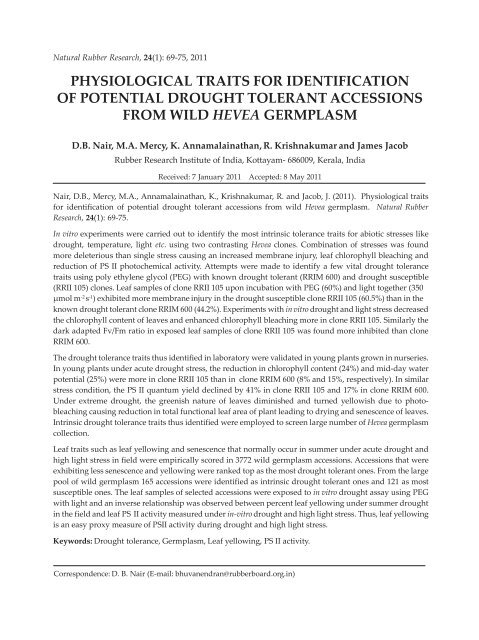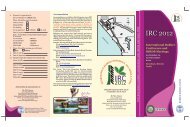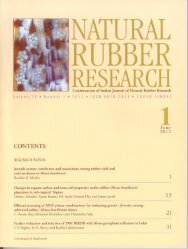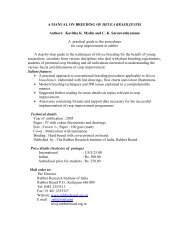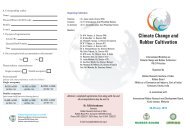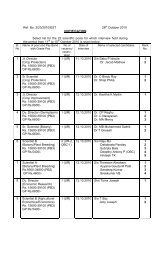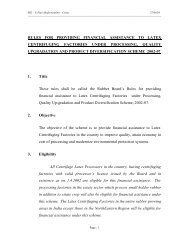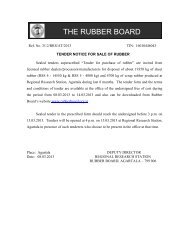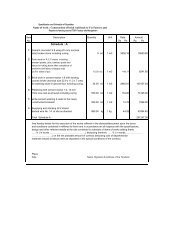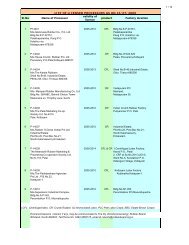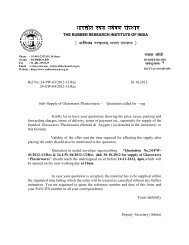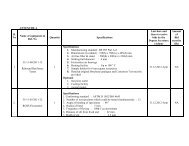to read the publication - Rubber Board
to read the publication - Rubber Board
to read the publication - Rubber Board
Create successful ePaper yourself
Turn your PDF publications into a flip-book with our unique Google optimized e-Paper software.
Natural <strong>Rubber</strong> Research, 24(1): 69-75, 2011<br />
PHYSIOLOGICAL TRAITS FOR IDENTIFICATION<br />
OF POTENTIAL DROUGHT TOLERANT ACCESSIONS<br />
FROM WILD HEVEA GERMPLASM<br />
D.B. Nair, M.A. Mercy, K. Annamalainathan, R. Krishnakumar and James Jacob<br />
<strong>Rubber</strong> Research Institute of India, Kottayam- 686009, Kerala, India<br />
Received: 7 January 2011 Accepted: 8 May 2011<br />
Nair, D.B., Mercy, M.A., Annamalainathan, K., Krishnakumar, R. and Jacob, J. (2011). Physiological traits<br />
for identification of potential drought <strong>to</strong>lerant accessions from wild Hevea germplasm. Natural <strong>Rubber</strong><br />
Research, 24(1): 69-75.<br />
In vitro experiments were carried out <strong>to</strong> identify <strong>the</strong> most intrinsic <strong>to</strong>lerance traits for abiotic stresses like<br />
drought, temperature, light etc. using two contrasting Hevea clones. Combination of stresses was found<br />
more deleterious than single stress causing an increased membrane injury, leaf chlorophyll bleaching and<br />
reduction of PS II pho<strong>to</strong>chemical activity. Attempts were made <strong>to</strong> identify a few vital drought <strong>to</strong>lerance<br />
traits using poly ethylene glycol (PEG) with known drought <strong>to</strong>lerant (RRIM 600) and drought susceptible<br />
(RRII 105) clones. Leaf samples of clone RRII 105 upon incubation with PEG (60%) and light <strong>to</strong>ge<strong>the</strong>r (350<br />
µmol m -2 s -1 ) exhibited more membrane injury in <strong>the</strong> drought susceptible clone RRII 105 (60.5%) than in <strong>the</strong><br />
known drought <strong>to</strong>lerant clone RRIM 600 (44.2%). Experiments with in vitro drought and light stress decreased<br />
<strong>the</strong> chlorophyll content of leaves and enhanced chlorophyll bleaching more in clone RRII 105. Similarly <strong>the</strong><br />
dark adapted Fv/Fm ratio in exposed leaf samples of clone RRII 105 was found more inhibited than clone<br />
RRIM 600.<br />
The drought <strong>to</strong>lerance traits thus identified in labora<strong>to</strong>ry were validated in young plants grown in nurseries.<br />
In young plants under acute drought stress, <strong>the</strong> reduction in chlorophyll content (24%) and mid-day water<br />
potential (25%) were more in clone RRII 105 than in clone RRIM 600 (8% and 15%, respectively). In similar<br />
stress condition, <strong>the</strong> PS II quantum yield declined by 41% in clone RRII 105 and 17% in clone RRIM 600.<br />
Under extreme drought, <strong>the</strong> greenish nature of leaves diminished and turned yellowish due <strong>to</strong> pho<strong>to</strong>-<br />
bleaching causing reduction in <strong>to</strong>tal functional leaf area of plant leading <strong>to</strong> drying and senescence of leaves.<br />
Intrinsic drought <strong>to</strong>lerance traits thus identified were employed <strong>to</strong> screen large number of Hevea germplasm<br />
collection.<br />
Leaf traits such as leaf yellowing and senescence that normally occur in summer under acute drought and<br />
high light stress in field were empirically scored in 3772 wild germplasm accessions. Accessions that were<br />
exhibiting less senescence and yellowing were ranked <strong>to</strong>p as <strong>the</strong> most drought <strong>to</strong>lerant ones. From <strong>the</strong> large<br />
pool of wild germplasm 165 accessions were identified as intrinsic drought <strong>to</strong>lerant ones and 121 as most<br />
susceptible ones. The leaf samples of selected accessions were exposed <strong>to</strong> in vitro drought assay using PEG<br />
with light and an inverse relationship was observed between percent leaf yellowing under summer drought<br />
in <strong>the</strong> field and leaf PS II activity measured under in-vitro drought and high light stress. Thus, leaf yellowing<br />
is an easy proxy measure of PSII activity during drought and high light stress.<br />
Keywords: Drought <strong>to</strong>lerance, Germplasm, Leaf yellowing, PS II activity.<br />
Correspondence: D. B. Nair (E-mail: bhuvanendran@rubberboard.org.in)


